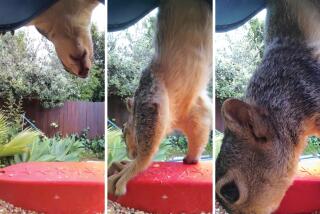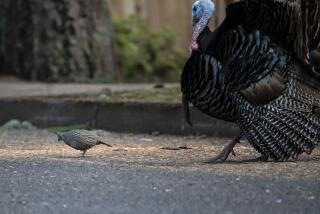Farewell, My Turkey : The gobbler was gone. His disappearance had just about knocked the stuffing out of me. But I promised myself I’d get to the bottom of the case, even if I had to ruffle some feathers.
“The gobbler’s flown the coop.”
That’s what the husky voice mumbled to me over the telephone. The words hung in the air like a giant Snoopy balloon at the Macy’s Thanksgiving Day parade.
I knew right away it was foul play. Make that fowl play. A turkey doesn’t just get up and leave. Not this turkey. Not Sid. After all, only a month ago I held him upside down at Gary Lee’s turkey ranch. That must have meant something to him.
I remembered how Sid’s little turkey feet wriggled when I cradled his claws in my hand that first time. His feet were coarse, like the skin of an acne-scarred commercial fisherman.
Was it fate that drove me to Lee’s ranch in Lockwood Valley? It was more than that. It was a friend and his truck. We traveled from Ventura, over Pine Mountain Summit into Cuyama Valley. The ranch is tucked away near Lake of the Woods, where Boy Scout Camp Road comes to a dead end.
It took us an hour and a half to get there. The browns and greens of the dry, tree-covered hills gave way to feathers, soft, fluffy and snow white, blanketing the dirt both inside and outside the turkey pens. It reminded me of a childhood pillow fight I might have had with my sister. Only I didn’t have a sister. Anyway, there were 25,000 turkeys.
We got the royal tour. First the brooder house, a sort of fowl day-care facility. One brooder for every 400 turkeys, with water dispensers and feed lines colored cranberry-sauce red. Soft wood shavings cushioned the tiny poult bodies.
They arrive from a hatchery at two days of age. The young birds live here for the next 15 days. Then they’re allowed to roam inside and outside the brooder. At six weeks, they hit the pavement, or in this case, the dirt.
“We drive them like you would drive cattle,” Lee told me. “It takes three to four people. . . . It takes about a week” because of the large number of birds.
At the end of the drive wait the range pens. Eight square feet of land per bird. Some of the turkeys were stepping on each other. But Sid wasn’t complaining.
From the moment I laid eyes on his snood, hanging there over his beak, I knew Sid would be the friendliest, most sophisticated of the flock. But I wanted Lee’s opinion. I asked him about their personalities. He said they didn’t have any.
However, Lee said, “I’ve had some that can be pretty mean, especially the older they get. We’ve raised some to 35 pounds and if one of those takes a run at you, it can knock you down.”
Sid would never do that, I thought.
We stayed for a couple of hours. I hated to leave Sid, but there would always be a next time, I thought. The turkeys were getting ready to bed down for the night.
“They lie flat, like mats. They sleep in a group,” Lee said. “People who don’t know they are sleeping think they are dead.”
Dead. The word didn’t mean much then. But after I got to thinking about the mysterious gobbler call, Lee’s remark rang in my head like a telephone in a monastery.
I had to find Sid. But first I had to figure out who would pluck a turkey out of his pen--maybe even bump him off. It was time to work the phones.
The Ventura County Historical Society promised to get back to me. The National Turkey Federation in Reston, Va., sent me literature. I learned that the first meal Neil Armstrong and Buzz Aldrin ate on the moon was roasted turkey from a foil packet. It didn’t help.
Then I discovered that Americans ate 18.4 pounds of turkey per capita last year, that Californians ate about 26. I learned, too, that turkey is considered a healthy food. Healthy. For whom?
I went looking for healthy people, and found Linda Dahl, a registered dietitian at Los Robles Regional Medical Center in Thousand Oaks.
A turkey, she said, is lower in total fat than beef or other red meat. Furthermore, she said, a turkey “is a good source of protein and it’s economical, especially at this time of year. Normally it’s readily available, but I can’t say that, because you lost yours.”
You bet I had, ma’am. But what did she mean, this time of year ? Basketball season?
Next came a little history lesson from John Voris, area turkey specialist for the University of California Cooperative Extension program.
Once upon a time, Voris said, more than 1,000 turkey ranchers produced 15 million turkeys a year in California. Now, he said, there are fewer companies and more turkeys. About 235 ranchers produce 30 million turkeys every year.
Most of those ranchers send the fattened birds to processing companies like Zacky Farms, ConAgra, Louis Rich and Foster Farms. They’re all in the San Joaquin Valley, Voris said, and to save money, ranchers almost always run their operations within 50 miles of the processors.
But Lee’s ranch sends turkeys to Zacky Farms in Fresno--more than 120 miles away. The Lee operation, which raised its first turkeys in 1929, is now the only turkey ranch in Ventura County. It keeps going in part because Lee’s family also operates a larger facility in Fresno.
But what did this mean for Sid? Probably that he wasn’t abducted by a competing ranch.
Voris was spilling a lot, so I asked why Californians eat more turkey per capita than the rest of the nation.
“There are several reasons,” he said. “We have an extremely diverse ethnic population. We’re also very innovative. Anything that happens in the United States happens in California first. We’re more crazy, more fad-conscious, more health-conscious.”
Fine. But what about our turkeys?
I had ruled out the possibility that Sid left on his own. Maybe I had jumped to the wrong conclusion. Maybe he had skipped town, hit the road, high-tailed it out of there. Who would understand the bird brain? I tried the Audubon Society.
“Turkeys belong to the chicken family,” said Elliot McClure, a member of the Ventura chapter. “They’re really just big chickens.” McClure said turkeys live to be 4 or 5 years old in the wild. Sid, at this point, was about 15 weeks old.
I asked McClure for a personality profile. “It depends on the bird,” he chirped. “You can’t characterize any group of people as one.” He said the same is true of turkeys. “They do have personalities. They’re very capable in the wild because they have to be.”
And when they’re not in the wild?
“When you domesticate animals, you make dummies out of them. Just look at what happens in L.A. with the people.”
I was still thinking about that when the Historical Society called back. They had the goods, in their library. I drove over like a madman. I parked. I entered the Ventura County Museum of History & Art and proceeded up the stairs toward the library.
And what I saw at the top of the stairs almost did me in. Sid.
After a second or two I realized it wasn’t Sid. He’s not a watercolor. It was a painting of a turkey. A haunting replica. This case was getting to me.
I looked over the information the staff had collected and found that Moorpark had been the turkey capital of the county in the mid-1940s. A couple of guys named Marvin and Wayne Paige used to ship turkeys across the country and overseas.
Solid information, but there was something missing. Clues. That was it. I checked a couple of other sources. I even tried calling a couple of local egg artists to see if they had come across Sid’s extra large eggs. Then I realized Sid was a male. He was talented, but not that talented.
It was looking bleak. Then I remembered Lee mentioning a Harold Stout at Zacky Farms. I didn’t know why I should bother; Sid had never been employed there, as far as I knew. But I called and spoke with the receptionist.
“He’s in the turkey plant,” she said. Hmm, I thought.
When I finally got through to Stout his first words were, “After the turkeys are picked up they come to the processing plant, or kill plant, here in Fresno.”
What a thought: Sid, dead in Fresno. How would I ever forget how he waddled into my life, how his shriveled neck turned blue when he got excited? I began to shake like a hula dancer on a subway car. I was depressed. But I was also wrong. And the case was about to take its final turn.
A day later, after long hours wandering the county, I faced up to my hunger and stumbled into a supermarket. It was freezing. To my left, fish sticks. To my right . . . Sid.
Here he was, not dead in Fresno but processed and featherless in the frozen-food aisle. Under the alias Tom. With a whole bin full of other so-called Toms. My head spun. I crumpled to the tile. Thanksgiving Special, said the banner above.
It all made sense now. Sid was a victim of circumstance. The right species in the wrong place at the wrong time.
I picked myself up and headed outside. It was partly cloudy. Just like so many other Ventura County days. The intersections were backed up. I reached into my coat pocket for my date book.
“T-Day dinner at mom’s,” it said. I’d be there. Just like I was every year. But this year, I’d reach for the ham and yams.






